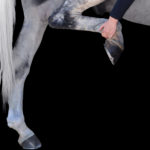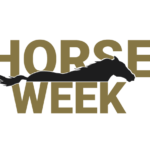The 2015 Pan American Games dressage competition took place July 9–14 at Canada’s Caledon Equestrian Park in Palgrave, Ontario, about an hour north of Toronto, the host city of the XVII Pan Am Games. It would turn out to be a milestone event on several levels, including a blended format combining Small Tour with Big Tour horses and riders competing for one set of medals for the first time in the history of international championship dressage. The United States dressage team arrived in Toronto with a purpose that would achieve two goals: a gold team medal would maintain the U.S. team’s two-decade-long winning streak, but even more importantly, it would secure a team spot for the USA at the 2016 Olympics in Rio de Janeiro, Brazil.
Veterans and Newcomers
It was thanks, in part, to the historic mixed-level format that the U.S. team included a combination of experienced members and first-timers. Team anchor Steffen Peters was defending his individual Pan Am gold medal from Guadalajara four years ago, where he won decisively with Weltino’s Magic. His partner at the 2015 Pan Am Games was Legolas 92, Four Winds Farm’s 13-year-old Westfalian gelding. Laura Graves and Verdades were the second Grand Prix level combination on the team. Just a year ago, Graves was a first-time team member herself, but she was regarded as a relative old hand on this team, since both of the Small Tour combinations were the true newcomers to the U.S. team at a major games. Kimberly Herslow and Rosmarin, a pair that had demonstrated consistency in delivering high scores at the Prix St. Georges and Intermediate I level, would turn out to be invaluable in contributing the highest team result of the entire competition. The fourth team members were Sabine Schut-Kery and Alice Womble’s 9-year-old Hanoverian stallion, Sanceo, another pair that had proven themselves throughout the team qualifiers.
Going into the team championship, the U.S. could see a clear path to gold with the only potential barrier coming from the host country’s young but talented team. By the second day’s Intermediate I and Grand Prix Special class, the scoreboard was peppered with scores above 75 percent from both countries. Two first-timers to the Canadian team, Brittany Fraser riding All In and Chris von Martels with Zilverstar, had posted the highest scores of their careers. They led Grand Prix teammates Belinda Trussell on Anton and Megan Lane on Caravella to a team silver medal that came much closer to challenging the Americans for gold than anyone had anticipated, coming within six points of the U.S. team.
An even closer battle for bronze took place between Brazil and Mexico. Strong performances from Brazil’s top three individuals kept next year’s Olympic hosts just two points ahead of Mexico, a team with only three members and no drop score. Mexico was one of only four countries along with the U.S., Canada and Argentina to field a team with at least one Grand Prix combination. Six more entirely Small Tour teams—from Colombia, Guatemala, Venezuela, Costa Rica and Chile—brought the total number of teams to 10, with an additional six nations represented by individuals. The mixed format that put Small Tour and Big Tour competitors in the same class was organized with all the Small Tour combinations going before the Grand Prix competitors.
Freestyle Comeback
While his three teammates all enjoyed improved results from the first to the second team round, Peters suffered disappointment in the Grand Prix Special test. Trouble started early when Legolas broke in the first transition from passage to extended trot. “He felt quite uncomfortable in his back and very tight,” Peters said afterward. “I know that causes problems in the tempi changes. Thank God for my test yesterday and for my teammates, who brought us along.”
Peters’ Grand Prix Special score was the lowest posted by any U.S. team member that day, but the 1.5 percent bonus that each Grand Prix level competitor received in the team results meant that his score with the bonus was still among the top three scores for the overall team score.
The freestyles took place after a rest day that followed the team competition. The individual medals were decided completely on the results of the freestyle, which started with a clean slate for the top half of the field in both the Small and Big Tour. But before the freestyle could even get under way, there were 24 hours of confusion as well as protests from two Latin American countries, regarding the number of athletes per nation who would be allowed to start in the freestyle. In the absence of any information in the Pan Am Games Technical Manual for Equestrian regarding the number of athletes per nation eligible to advance to the individual final, it was decided that all four athletes could advance if they were qualified in the rankings. The initial draw included Schut-Kery with Sanceo and Canada’s fourth-ranked individual, Megan Lane and Caravella. A second draw was held a full day later after meetings and consultations with the Pan Am Games governing body, the Pan American Sports Organization (PASO), which concluded that only three athletes may proceed to an individual final—a formula that has long been in place at the Olympics, WEG and the Pan Am Games, and is standard for other sports at major Games. This decision excluded Schut-Kery and Lane from the freestyle.
“The organization did not come through with regard to knowing if it was three or four riders who would go forward to the final,” said U.S. dressage team chef d’equipe Robert Dover. “It was very hard on two riders in particular, but also their teammates, sponsors, owners and trainers. It was hard on the sport in general.”
As consolation for the rider’s last-minute exclusion, the Pan Am Games organizers invited Schut-Kery to perform her Intermediate I freestyle as a test ride before the first competitor and Lane to perform a test freestyle ride before the first Grand Prix freestyle.
The first Americans to compete in the freestyle were Herslow and Rosmarin, who were not able to continue the flawless trend they had established in the team competition. Small issues in the tempi changes were compounded by a more costly mistake in one of the pirouettes. Herslow would finish the day in eighth place. Peters, third from last to go, demonstrated what an experienced and consummate competitor he is. Gone were the mistakes of the Grand Prix Special. Legolas performed much more to the standard that the world has come to expect of him, delivering what would stand as the gold-medal-winning test.
Graves and Verdades were the last pair down centerline. The 14-year-old gelding had shown signs of nerves in the atmosphere of the Pan Am arena throughout the three days, but by the second half of their freestyle they had found their groove. Graves’ difficult choreography kept her just a third of a point ahead of Canada’s bronze-medal-winning Small Tour combination, von Martels and Zilverstar.
Herslow’s High
Competing for the first time on the U.S. dressage team at a major Games inevitably brings a certain amount of pressure. Add to that the additional responsibility of ensuring that the team earns the only remaining team berth for the 2016 Olympics, and you have what Herslow experienced in Toronto. “It’s incredible to come here, the first time on a major Games team, and it’s basically do or die to win gold,” she said.
Rosmarin, a 10-year-old Hanoverian gelding owned by Kiroli Enterprises LLC, proved that he can be counted on to produce top results under pressure. “We call him “The Mailman,” because he always delivers,” said Herslow. “He gave me so much this week, the most he’s ever given me in the ring.”
Herslow was not nearly as disappointed in her freestyle result as she was excited about how greatly Rosmarin had contributed in the team tests. She said finding herself the overall leader following the team competition was the highlight of her team debut. “Being on the podium was awesome, but when Robert brought my tests to me back at the hotel and showed me the paper that had me ranked first, I literally hit the floor. I was blown away. For my horse to have peaked at this time, it doesn’t get any better than that.”
Another highlight of the Pan Am experience for Herslow came from being on a team with the likes of Peters and Graves. “And to actually beat their scores is incredible,” she added. Herslow had traveled to Europe with her teammates in the lead-up to the Pan Am Games. She said the mileage she gained there was invaluable. “It was such an amazing experience in Europe. This is such an incredible team I’m on—the personalities, the horses—and everybody’s there for you and supporting you.”
Having now been bitten by the team bug, Herslow hopes to debut Rosmarin at Grand Prix in the coming months. “I’m not the type of rider to say, ‘I’m going to do it by this season.’ I’ll let my horse tell me when he’s ready for it. I want to be sure he can go out and put in his best performance.”
Steppingstone for the Americas
The Pan Am Games dressage competition has historically been a contest between two nations—the U.S. and Canada—for gold and silver. But for most of Central and South America, the Pan Am Games are a kind of Olympic Games in themselves. Dressage is developing quickly in the Americas, but few countries have the pool of horsepower or resources to field teams with even one Grand Prix combination. The long-term goal, as envisioned by the FEI, is for the Pan Am Games to be at Grand Prix level. In the meantime, sending a team to compete at the Small Tour level is an ultimate achievement for riders from countries like Guatemala, Venezuela and Costa Rica.
The three-member team from Costa Rica that competed at these Pan Am Games is a particularly special case. The Egerstrom family—Michelle, Cristobal and Ami—was the only Pan Am Games equestrian team entirely composed of one family, though it’s not the first time for this mother, father and daughter trio to be on a team together. At the 2011 Pan Am Games in Guadalajara, Ami (at the age of 18) competed alongside her parents as three members of Costa Rica’s four-member team. The Egerstroms also qualified Costa Rica for the 2015 Pan Am Games as a three-member team at the Central and Caribbean Games in Veracruz, Mexico last November.
“Competing on a team with both my parents is a great experience,” said Ami Egerstrom. “My dad has the experience of many games before him and my mom is great emotional support. My dad is our main trainer, but sometimes it’s hard to separate dad from coach. I know that as a dad he has high expectations of me and he pushes me to do my best.” Egerstrom said she has mixed feelings about being called “Team Egerstrom.”
“It is fun to be identified as a family team and it definitely makes me proud that we are a family team. However, at the end of the day, we are Team Costa Rica first. The family scenario is accidental. No one else could make it to Toronto with us, and it would have been nice to have a fourth teammate.”
For Costa Rica, whose team finished ninth in Toronto, the Pan Am Games are vital to developing dressage in that country. “We work really hard to make it to the Games,” said Egerstrom, “and we know we need to work harder still to make a team that is actually competitive against other Latin American teams.”
If the Pan Am Games were to be held entirely at the Grand Prix level, Egerstrom said Costa Rica would be among a number of nations that would not have been able to send a team. “Most of us couldn’t even produce one Grand Prix level team member for these Games. Nevertheless, I am sure a number of countries that didn’t produce one single Grand Prix ride will be trying to do so for the next Games if this format continues.”
Egerstrom is one of a number of people to have concluded that the mixed format of the Pan Am Games is a problematic formula. “I agree that Latin America should be encouraged to develop at the Grand Prix level, but I don’t think the Games are the place for it.”
To Be or Not To Be Grand Prix?
The Pan Am Games have long been criticized for being an Olympic qualifier because the competition is not held at the same level as at the Olympic Games. It took several years for the format in Toronto to be finalized. Apart from a couple of trial runs at the Global Dressage Festival’s Nations Cup, the mixed-level concept saw its real first test in Toronto. Teams that wanted to vie for the one Rio team berth were required to have at least one Grand Prix level combination in Toronto. Countries that included Grand Prix combinations on their teams (two Grand Prix members was the maximum allowed) were given incentive in the form of a 1.5 percent bonus per rider per test in the team competition. As it turns out, the medal results in Toronto were not affected by this bonus. Each of the medal-winning teams would have won the medals they received without it.
In the individual competition, medals were given out for the first time to competitors at different levels. Gold and silver were won by Grand Prix combinations, and bronze went to a Small Tour pair. The scores, just a half point apart from gold to bronze, would suggest that the playing field was remarkably level in spite of the different levels. Dover believes the experiment was a success.
“It was absolutely in the right direction that we went with this compromise to see how it worked,” he said. “It worked effectively and now what’s important is the next way forward.” Dover believes that at the next Pan Am Games the teams should be required to have at least three Grand Prix horses, though he recognizes that the FEI has not yet reached that decision. “We also want to see no fewer than two teams from the Pan Am Games taken for Olympic berths,” he said in reference to the FEI’s 2013 decision to reduce the number of Olympic-team qualifications at the Pan Am Games by half, from two to one. As it stands now, Canada has to try to qualify three individuals and form a composite team for Rio next year.
The next Pan Am Games will take place in Lima, Peru. The FEI plans to evaluate the outcome of Toronto’s mixed dressage team experiment and to make recommendations for 2019. Given the success of Toronto, it is likely that Peru will see more horses, rather than fewer at the Grand Prix level.






